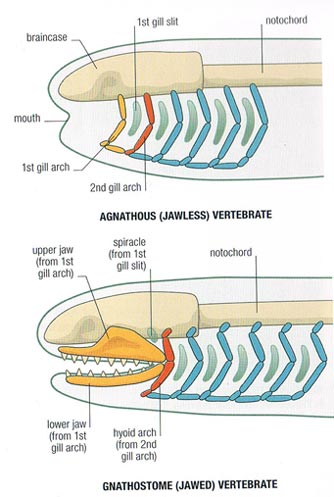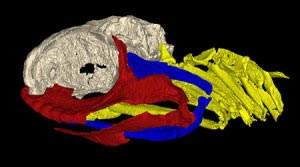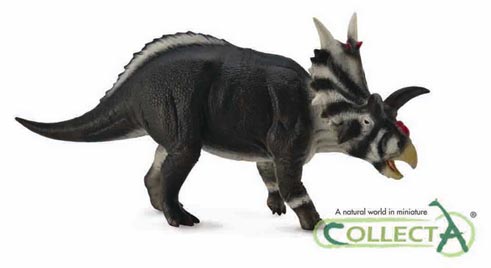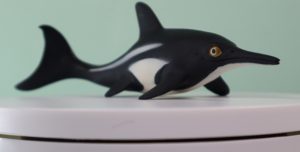325-Million-Year-Old Fossil Suggests Sharks are Not “Primitive”
Often described as a group of animals that have remained virtually unchanged for millions of years, extant shark species (and there are something like 470 known species) are actually more highly evolved than previously thought. The discovery of a remarkably well-preserved specimen of an ancient shark-like creature that once swam in a marine ecosystem more than 325 million years ago (Pennsylvanian Epoch of the Carboniferous), has provided palaeontologists with evidence to suggest that early cartilaginous and bony fishes have more to tell us about the evolution of jaws.
The Evolution of Jaws
A study published in the academic journal “Nature”, vividly demonstrates how new fossil discoveries can dramatically alter our understanding of the evolution of vertebrates. The fossil, a three-dimensional concretion, shows a combination of primitive and more advanced anatomical features in a cartilaginous fish, evidence of a sophisticated jaw has been identified along with a complete gill section. Importantly, the fossil shows the arrangement of the jaw and the gills “in situ”, the fossil has preserved these delicate organs in their natural, life position.
The layout of these anatomical features are very similar to that found in bony fishes as well as cartilaginous fish. This suggests that this specimen might represent a common ancestor of these extremely important vertebrates.
The Concretion that Represents the Fossilised Jaws and Gill Structures of a Palaeozoic Fish

Scale bar = 10 millimetres.
Picture credit: American Museum of Natural Hisotory/Pradel
The picture shows two lateral views (views from sideways on) of the fossil material that was later scanned at the European Synchrotron Radiation Facility to reveal its internal structures.
Ancient Shark Fossil
The first fish are believed to have evolved from Chordate animals (animals that possess a stiff rod that runs along or part-way along their body length for at least a portion of their life cycle). The evolutionary links remain poorly known but fossils found in China indicate that the first jawless fish, (agnathans) may have evolved more than 530 million years ago. It is believed that sometime during the Silurian geological period, a crucial development in the history of life on Earth occurred, the first vertebrates with true jaws (gnathostomes) evolved.
Part of the American Museum of Natural History Collection
Although, this fossil, part of an enormous fossil collection donated to the American Museum of Natural History by Ohio University, may not represent the earliest jawed fish, its state of preservation has provided scientists with an insight into the evolution of jaws from modified gill arches.
The Evolution of Jaws in Fish (Agnathan compared to a Gnathostome)

How jaws may have evolved.
Studying Agnathans
In jawless fish (agnathans), the first and second gill arches (branchial arches) support the first gill slit. In jawed vertebrates, the first gill arch has become a pair of jaws and the first gill slit a spiracle to let water pass over the remaining gills.
Lead author of the research paper, post-doctoral researcher at the New York based museum, Alan Pradel stated:
“Sharks are traditionally thought to be one of the most primitive surviving jawed vertebrates. Most textbooks in schools today say that the internal jaw structures of modern sharks should look very similar to those in primitive shark-like fishes, but we’ve found that’s not the case. The modern shark condition is very specialised, very derived and not primitive.”
The story of this significant breakthrough, starts with Ohio University professors Royal and Gene Mapes and their students, who over the years amassed in excess of half a million Palaeozoic fossils from Arkansas, Oklahoma and Texas. The fossils represent marine ecosystems and consist of invertebrates such as trilobites, ammonites, brachiopods and gastropods, as well as a number of fossils of primitive fish.
Ozarcus mapesae
The fossilised skull of the new species named Ozarcus mapesae is so well preserved it allowed scientists to create a three-dimensional model to show the organisation of the jaw in relation to the gill arches. The trivial name for this new species honours the Ohio University professors.
Fish heads, including cartilaginous fish such as sharks and rays, are segmented into the jaws and a series of arches that support both the jaw and the gills. However, as the fossils of most early gnathostomes (jawed fish) are poorly preserved and usually distorted and flattened, this is the oldest known specimen found to date that shows the jaw/gill arch relationship in such clarity.
A Computer Generated Image that shows the Internal Structures of the Fossil

3-D image of fossil produced.
Picture credit: American Museum of Natural History/Pradel
The picture above shows one of the three-dimensional images created after the fossil material had been bombarded with X-rays to produce the computer model. The brain case can be seen at the top (shaded a tan colour), the structure of the jaws are shaded red, the jaws having evolved from the first gill arch. The second gill arch, known as the hyoid arch is shown in blue. The remaining gill arches are shaded yellow.
The Importance of this Donated Specimen
Commenting on the importance of this donated specimen, one of the study authors, John Maisey (American Museum of Natural History) added:
This beautiful fossil offers one of the first complete looks at all of the gill arches and associated structures in an early shark. There are other shark fossils like this in existence, but this is the oldest one in which you can see everything. There is enough depth in this fossil to allow us to scan it and digitally dissect out the cartilage skeleton.”
In order to study the three-dimensional concretion so the layout and the orientation of the delicate branchial arches (gill arches) could be mapped, the scientists took the specimen to the European Synchrotron Radiation Facility (ESRF), located at Grenoble in France so that high-resolution X-rays could bombard the specimen and produce a detailed, computer generated image of the fossil in three-dimensions. The team discovered that the arrangement of gill arches is not like that seen in modern, extant sharks. Instead the gill layout is fundamentally similar to that seen in bony fishes (osteichthyans).
The authors state that it is not unexpected that sharks, because of their long evolutionary history, would undergo evolution of these anatomical structures, but bony fish may have more to tell us about the first jawed ancestors of land-living vertebrates such as ourselves than living sharks. Bony fish are the most successful group of gnathostomes. All tetrapods (that includes us) are descended from bony fish.
Sharks – A very Diverse and Geographically Widespread Group

Sharks – a diverse group with over 470 extant species.
Picture credit: Everything Dinosaur
For models and replicas of marine sea monsters and prehistoric sharks: PNSO Age of Dinosaurs Models.
















